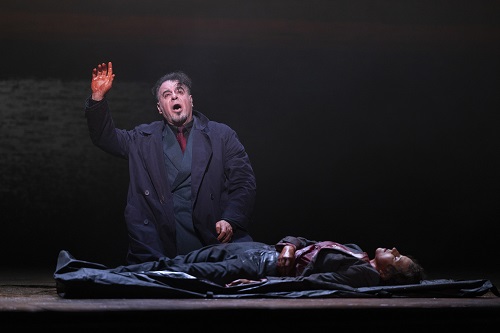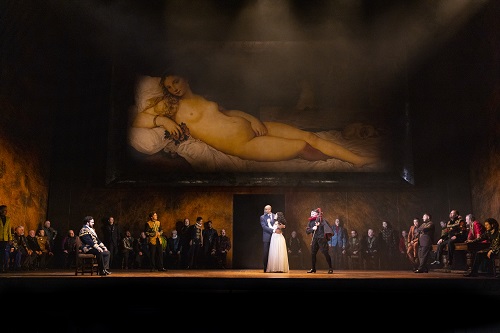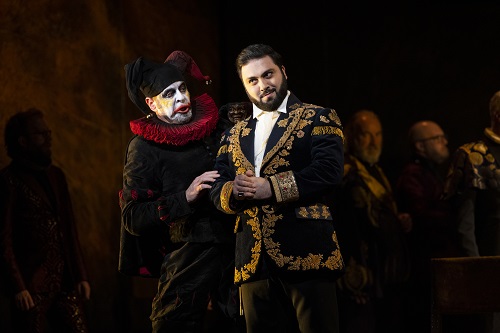It was an absolute delight to be back at the Royal Opera House for the opening night of the 2021-22 season, but also somewhat disorientating. A full auditorium; convivial operagoers bustling in the foyers and bars; familiar faces greeting colleagues at the press desk; a new production of Rigoletto to enjoy: had we all just closed our eyes in March 2020 and woken up eighteen months later? Well, no, of course not: and the buzz in the air was not just anticipation for the performance, and season, ahead, but also the thrill of being in an opera house at all.
And, in any case, it wasn’t ‘business as usual’, and I’m not just referring to the masks worn by audience members and orchestral musicians alike. Astonishingly, this is the first time during his nearly thirty-year tenure as Music Director of the Royal Opera House that Sir Antonio Pappano has conducted Verdi’s dark, vengeance-fuelled tragedy in the House. Indeed, he hasn’t conducted Rigoletto anywhere for 29 years. More than that, this production is also the first that Oliver Mears has directed at Covent Garden since becoming Director of Opera in 2017.

So, what would Mears offer us? And, looking ahead, would it give an indication of how future productions at the Royal Opera House might be shaped and influenced by Mears’ vision and choices? The second question can only be answered when we have the benefit of hindsight. The answer to the first is that Mears essentially ‘played it straight’ in a staging the biggest ‘swerve’ of which is to reveal the authentic Renaissance costumes of the Duke of Mantua’s courtiers (costume design, Ilona Karas) to be mere fancy-dress masquerading of modern-day bling-laden revellers. Simon Lima Holdsworth’s sets are bold, clear and uncluttered, and, as the opera progresses, increasingly unspecific of period and place. Mears gives the cast the space to communicate emotions, by and large without undue visual or kinetic distractions. Yet, despite this apparent ‘straightforwardness’, Mears draws upon the literary and visual arts to make us think more deeply about the drama’s familiar contexts, conflicts and characters, and to create compelling theatrical tableaux.

And, the latter are nowhere more striking than in the opera’s opening moments when, during the closing bars of an overture dominated by the menacing growl of the ROH brass section, the curtain rises to reveal a human reconstruction of Caravaggio’s The Martyrdom of Saint Matthew, brilliantly lit by Fabiana Piccioli. Spotlights against the opaque tenebrist gloom isolate the moment that the assassin – sent by the King of Ethiopia whom the Evangelist has condemned for lusting after his own niece, the nun Iphigenia – plunges his sword into the prone figure of Saint Matthew, and highlight the facial expressions of the onlookers. Except that on this occasion, the horrified observers are not witnessing the imminent martyrdom of a Saint but the metaphorical deflowering of a woman in virginal white; and, rather than recoiling from the violence they, and, in the shadows, Rigoletto, are revelling in the power of patriarchy.
When the human statues are set free from Caravaggio’s frozen moment, we understand that their artistic impersonation has been designed for the pleasure of the Duke of Mantua, a connoisseur and commodifier of both art and women. The tableau tells us all we need to know about the drama to come (perhaps it also weakens the opportunity for dramatic or visual surprise subsequently?) in which the women duly line up to serve the Duke’s desire for sexual and social domination. And, the striking opening visual statement also establishes another drama, that of light and darkness, which Mears sustains literally and figuratively throughout the production. For, Hugo’s deformed jester embodies the narrow and blurred dividing lines between ugliness and beauty, evil and goodness, and in this way, just as the hunchback is the deformed subject of a work of artistic beauty, so the immoral (in this production verging on viciously vice-obsessed) Duke’s passion for the visual arts brings the duality of human behaviour to the fore.

Titian’s Venus of Urbino – in which the iconography of fidelity is challenged by the flirtatious gaze of the young girl who sprawls, naked, waiting to be dressed for the betrothal ceremony the Venetians call il toccamano – and Rape of Europa may hang from the Duke’s walnut-panelled walls but they effect no moral improvement in their owner. Does his sadism defile their sublimity? How can Gilda be the daughter of the deformed, diabolical jester? Such questions Mears invites us to ponder. Less successful are his efforts to highlight the Lear parallels: yes, a father-daughter relationship is at the core of both tragedies, and there’s a pivotal storm and a Fool in both texts, but the infliction of Gloucester’s punishment on Monterone does not sit comfortably with the music.

What I did find compelling was the way that the dark-light opposition was shown to be embodied by the scenic structure and physical locations of the opera. The ducal palace, a place of lust, laughter and licentiousness, is juxtaposed in Act 1 with the protective affection of the paternal love which warms Rigoletto’s sparse home. The grandmasters are thus replaced by a girl’s simple bedroom, adorned by a plain Madonna, lit by candles and viewed through a sheer drape curtaining a cutaway window.
But, Mears shows us that dark and light are not so unequivocally separated. The jester is complicit in the court’s corruption; the abductors enter his home and violate his daughter. Monterone’s curse connects the two worlds, and in Act 2 Rigoletto returns to the court as both Fool and father. The grey between the overlapping black and white is embodied by the anonymous street where Rigoletto encounters Sparafucile, and it is here, in a moral no-man’s land, where the action ends, in a dilapidated inn on the deserted banks of the Mincio river. Mears and Holdsworth make this visually and theatrically clear, and at the close – as set gives way to just sea and sky, and Rigoletto cradles the dead Gilda – we might well remember Edgar and Gloucester on the cliff top; or, Lear on the heath, with just the Fool for company, raging at the storm and at his daughters’ abusiveness.

If Mears gives us much to look at and reflect upon, then Pappano and the cast provide a feast for the ears. Pappano sweeps us through the score brilliantly balancing dramatic structure with pulsating feeling. If at times he gives the ROH instrumentalists a little too much free rein – the cello solo in Rigoletto’s Act 2 ‘Cortigiani, vil razza dannata’ was beautifully played but rather overshadowed the hunchback’s pleas for the return of his daughter – then it’s really just such a pleasure to enjoy a full orchestral canvas that no-one could complain. The male chorus are tightly choreographed and appropriately swaggering; their abduction mime-narration is skilfully executed.
Liparit Avetisyan is a committed and charismatic Duke, not afraid to boom and roar but vocally stylish and suave. Carlos Álvarez makes one both recoil from and rue for Rigoletto; he paces himself effectively – though his final discovery of his daughter’s corpse felt a little low-key – and wears his emotions on his vocal sleeve. This directness makes his duets with Lisette Oropesa’s Gilda both captivatingly persuasive and sometimes painfully raw. Rigoletto’s fatherly love and his adulation of Gilda’s saintliness both inspire and oppress her. Her own passion for the Duke becomes thus a thing of shame – a shame which is doubled by his subsequent violation of her love. Oropesa communicates both Gilda’s youthful sensuality – as she reclines on her bed, stroking her legs as she dreams of her beloved ‘Gualtier Maldè’, it’s clear that she’s not as innocent as her father thinks – and traumatised disillusionment. Oropesa is simply superb: ‘Caro nome’ was beautifully ornamented and bravely, brilliantly executed. The coloratura soprano absolutely deserved her thunderous ovation.

The comprimario roles are well sung, with Ramona Zaharia an appealing Maddelena and Brindley Sherratt a fittingly nasty Sparafucile. Three Jette Parker Young Artists, Kseniia Nikolaieva (Giovanna), Egor Zhuravskii (Borsa) and Blaise Malaba (Count Ceprano) must have been relieved finally to perform in a grand opera in this grand venue, joining Dominic Sedgwick (Marullo) and Amanda Baldwin (Countess Ceprano) in the minor roles, with only Eric Greene’s Monterone seeming out of sorts.
Interestingly, earlier in the day Mears had joined Tom Sutcliffe’s guests on Radio 4’s Start the Week, and during the conversation had remarked upon opera’s cathartic power. That his own production seemingly undermines the Aristotelian theory that he had espoused, paradoxically deepened the ‘message’ of this Rigoletto. But, whatever the ‘power and purpose’ of art, Mears and Pappano remind us why we love it, and need it, so much.
Claire Seymour
Verdi: Rigoletto
Duke of Mantua – Liparit Avetisyan, Rigoletto – Carlos Álvarez, Gilda – Lisette Oropesa, Sparafucile – Brindley Sherratt, Maddalena – Ramona Zaharia, Giovanna – Kseniia Nikolaieva, Count Monterone – Eric Greene, Marullo – Dominic Sedgwick, Borsa – Egor Zhuravskii, Count Ceprano – Blaise Malaba, Countess Ceprano – Amanda Baldwin, Page –Louise Armit, Court Usher – Nigel Cliffe; Director – Oliver Mears, Conductor – Antonio Pappano, Set designer – Simon Lima Holdsworth, Costume designer – Ilona Karas, Lighting designer – Fabiana Piccioli, Movement Director – Anna Morrissey, Chorus and Orchestra of the Royal Opera House.
Royal Opera House, Covent Garden, London; Monday 13th September 2021.
ABOVE: Rigoletto at the Royal Opera House (c) Ellie Kurttz